Quantitative Estimation of the Effects of Soil Moisture on Temperature Using a Soil Water and Heat Coupling Model
Abstract
:1. Introduction
2. Materials and Methods
2.1. Study Region and Field Experiments
2.2. Model Development
2.2.1. General Relationship Equation of Soil Water and Heat
2.2.2. Radiation and Flux Module
2.2.3. Soil Water Balance and Transport Module
2.2.4. Soil Heat Conduction Module
2.2.5. Ground and Air Temperature Regression Module
2.3. Model Calibration and Validation
3. Results
3.1. Evaluations of the Model Performances
3.2. Sensitivity of Soil Temperature to the Changes in Soil Moisture
3.3. Contribution of Soil Moisture Changes to Soil Surface Temperature Increase under Different Initial Conditions
4. Discussion
4.1. The Effects of Soil Moisture in Spring on Soil Temperature in Summer
4.2. The Positive Feedback Effect of Soil Moisture Decrease and Soil Surface Temperature Increase
4.3. Applicability and Limitations of the Model
- The disturbances of the cold and heatwaves have a great influence on the model; therefore, in the future research, it is necessary to quantify the influence of the synoptic process and optimize the model further.
- The model does not take into account the condition when the net radiation is negative and cannot simulate snow cover and frozen soil, to date.
- The model does not consider the water replenishment of groundwater to shallow soil.
- The model performed well in the Wuchuan County, but due to the differences in natural conditions in different regions (such as climate types, land cover and soil texture), the applicability of the model needs to be verified further.
5. Conclusions
Author Contributions
Funding
Institutional Review Board Statement
Informed Consent Statement
Data Availability Statement
Conflicts of Interest
References
- Hauser, M.; Orth, R.; Seneviratne, S.I. Role of soil moisture versus recent climate change for the 2010 heat wave in western Russia. Geophys. Res. Lett. 2016, 43, 2819–2826. [Google Scholar] [CrossRef]
- Koster, R.D.; Dirmeyer, P.A.; Guo, Z.C.; Bonan, G.; Chan, E.; Cox, P.; Gordon, C.T.; Kanae, S.; Kowalczyk, E.; Lawrence, D.; et al. Regions of strong coupling between soil moisture and precipitation. Science 2004, 305, 1138–1140. [Google Scholar] [CrossRef] [PubMed]
- Li, R.L.; Bao, H.Y.; Li, K.C.; Wang, C.H. The memory and climate effects of global soil moisture. J. Glaciol. Geocryol. 2016, 38, 1470–1481. (In Chinese) [Google Scholar]
- Zhang, J.; Liu, Z.Y.; Chen, L. Reduced soil moisture contributes to more intense and more frequent heat waves in Northern China. Adv. Atmos. Sci. 2015, 32, 1197–1207. [Google Scholar] [CrossRef]
- Kai, Y.; Zhang, J. Spatiotemporal characteristics of soil temperature memory in China from observation. Theor. Appl. Climatol. 2015, 126, 739–749. [Google Scholar]
- Zhang, Z.Y.; Pan, Z.H.; Pan, F.F.; Zhang, J.; Han, G.L.; Huang, N.; Wang, J.L.; Pan, Y.Y.; Wang, Z.Z.; Peng, R.Q. The Change Characteristics and Interactions of Soil Moisture and Temperature in the Farmland in Wuchuan County, Inner Mongolia, China. Atmosphere 2020, 11, 503. [Google Scholar] [CrossRef]
- Zeng, X.M.; Wang, B.; Zhang, Y.; Song, S.; Huang, X.; Zheng, Y.; Chen, C.; Wang, G. Sensitivity of high-temperature weather to initial soil moisture: A case study using the WRF model. Atmos. Chem. Phys. 2014, 14, 9623–9639. [Google Scholar] [CrossRef]
- Erdenebat, E.; Sato, T. Role of soil moisture-atmosphere feedback during high temperature events in 2002 over Northeast Eurasia. Prog. Earth Planet. Sci. 2018, 5, 37. [Google Scholar] [CrossRef]
- Zaitchik, B.F.; Macalady, A.K.; Bonneau, L.R.; Smith, R.B. Europe’s 2003 heat wave: A satellite view of impacts and land-atmosphere feedbacks. Int. J Climatol. 2006, 26, 743–769. [Google Scholar] [CrossRef]
- Kirien, W.; Jakob, Z.; Rene, O.; Mxolisi, S.; Mohammad, R.; Ernest, O.A.; Sonia, I.S. Impact of soil moisture on extreme maximum temperatures in Europe. Weather Clim. Extrem. 2015, 9, 57–67. [Google Scholar]
- Seneviratne, S.I.; Davin, E.; Hirschi, M. Soil Moisture-Ecosystem-Climate Interactions in a Changing Climate. In Proceedings of the AGU Fall Meeting, San Francisco, CA, USA, 5–9 December 2011. [Google Scholar]
- Fischer, E.M.; Seneviratne, S.I.; Vidale, P.L.; Luthi, D.; Schar, C. Soil Moisture Atmosphere Interactions during the 2003 European Summer Heat Wave. J. Clim. 2007, 20, 5081–5099. [Google Scholar] [CrossRef]
- Deng, Y.H.; Wang, S.J.; Bai, X.Y.; Luo, G.J.; Wu, L.H.; Cao, Y.; Li, H.W.; Li, C.J.; Yang, Y.J.; Hu, Z.Y.; et al. Variation trend of global soil moisture and its cause analysis. Ecol. Indic. 2019, 110, 105939. [Google Scholar] [CrossRef]
- Seneviratne, S.I.; Corti, T.; Davin, E.L.; Hirschi, M.; Jaeger, E.B.; Lehner, I.; Orlowsky, B.; Teuling, J. Investigating soil moisture–climate interactions in a changing climate: A review. Earth Sci. Rev. 2010, 99, 125–161. [Google Scholar] [CrossRef]
- Luterbacher, J.; Dietrich, D.; Xoplaki, E.; Grosjean, M.; Wanner, H. European Seasonal and Annual Temperature Variability, Trends, and Extremes Since 1500. Science 2004, 303, 1499–1503. [Google Scholar] [CrossRef]
- Hui, Y.; Li, C.Y. Diagnostic Study of Serious High Temperature over South China in 2003 Summer. Clim. Environ. Res. 2005, 10, 80–85. (In Chinese) [Google Scholar]
- Zhang, J.Y.; Wu, L.Y. Land-atmosphere coupling amplifies hot extremes over China. Chin. Sci. Bull. 2011, 56, 3328–3332. [Google Scholar] [CrossRef]
- Venkat, L.; Jackson, T.J.; Diane, Z. Soil moisture–temperature relationships: Results from two field experiments. Hydrol. L Processes 2003, 17, 3041–3057. [Google Scholar]
- Douville, H. Relative contribution of soil moisture and snow mass to seasonal climate predictability: A pilot study. Clim. Dyn. 2010, 34, 797–818. [Google Scholar] [CrossRef]
- Khodayar, S.; Sehlinger, A.; Feldmann, H.; Kottmeier, C. Sensitivity of soil moisture initialization for decadal predictions under different regional climatic conditions in Europe. Int. J. Climatol. 2015, 35, 1899–1915. [Google Scholar] [CrossRef]
- Subin, Z.M.; Koven, C.D.; Riley, W.J.; Torn, M.S.; Lawrence, D.M.; Swenson, S.C. Effects of Soil Moisture on the Responses of Soil Temperatures to Climate Change in Cold Regions. J. Clim. 2013, 26, 3139–3158. [Google Scholar] [CrossRef]
- Li, C. A model of nitrous oxide evolution from soil driven by rainfall events: 1. Model structure and sensitivity. J. Geophys. Res. 1992, 97, 9759–9776. [Google Scholar] [CrossRef]
- Tsuji, G.; Uehara, G.; Balas, S. DSSAT Version 3, 3rd ed.; University of Hawaii: Honolulu, HI, USA, 1994. [Google Scholar]
- Bonan, G.B.; Oleson, K.W.; Vertenstein, M.; Levis, S.; Zeng, X.B.; Dai, Y.J.; Dickinson, R.E.; Yang, Z.L. The Land Surface Climatology of the Community Land Model Coupled to the NCAR Community Climate Model. J. Clim. 2002, 15, 3123–3149. [Google Scholar] [CrossRef]
- Neitsch, S.L.; Arnold, J.G.; Kiniry, J.R.; King, K.W. Soil and Water Assessment Tool Theoretical Documentation Version 2000, 3rd ed.; Blackland Research Center: Temple, TX, USA, 2002. [Google Scholar]
- Dai, Y.J.; Ji, D.Y. The Common Land Model (CoLM) Technical User’s Guide, 3rd ed.; Beijing Normal University: Beijing, China, 2008. [Google Scholar]
- Cheng, S.; Guan, X.; Huang, J.; Ji, F.; Guo, R. Long-term trend and variability of soil moisture over East Asia. J. Geophys. Res. Atmos. 2015, 120, 8658–8670. [Google Scholar] [CrossRef]
- Chen, Y.; Li, Z.; Fan, Y.; Wang, H.; Deng, H. Progress and prospects of climate change impacts on hydrology in the arid region of northwest China. Environ. Res. 2015, 139, 11–19. [Google Scholar] [CrossRef]
- Han, G.L.; Wang, J.L.; Pan, Y.Y.; Huang, N.; Zhang, Z.Y.; Peng, R.Q.; Wang, Z.Z.; Sun, G.F.; Liu, C.; Ma, S.Q.; et al. Temporal and Spatial Variation of Soil Moisture and Its Possible Impact on Regional Air Temperature in China. Water 2020, 12, 1807. [Google Scholar] [CrossRef]
- Zhang, J.T.; An, P.l.; Pan, Z.H.; Hao, B.Z.; Wang, L.W.; Dong, Z.Q.; Pan, X.B.; Xue, Q.W. Adaptation to a warming-drying trend through cropping system adjustment over three decades: A case study in the northern agro-pastural ecotone of China. J. Meteorol. Res. 2015, 29, 496–514. [Google Scholar] [CrossRef]
- Dong, Z.Q.; Pan, Z.H.; An, P.L.; Zhang, J.T.; Zhang, J.; Pan, Y.Y.; Huang, L.; Zhao, H.; Han, G.L.; Wu, D.; et al. A quantitative method for risk assessment of agriculture due to climate change. Theor. Appl. Climatol. 2016, 131, 653–659. [Google Scholar] [CrossRef]
- Li, H.X.; Xia, Z.Q.; Ma, G.H. Study on the effect of water content variation on soil temperature and water exchange. J. Hohai Univ. 2007, 35, 172–175. (In Chinese) [Google Scholar]
- Holmes, T.R.H.; Owe, M.; Jeu, R.A.M.D.; Kooi, H. Estimating the soil temperature profile from a single depth observation: A simple empirical heatflow solution. Water Resour. Res. 2008, 440, 103–112. [Google Scholar] [CrossRef]
- Allen, D.G.; Pereira, L.O.; Raes, D.; Smith, M. Crop Evapotranspiration: Guideline for Computing Crop Water Requirements, 3rd ed.; FAO: Rome, Italy, 1998.
- Flerchinger, G.N.; Pierson, F.B. Modeling plant canopy effects on variability of soil temperature and water. Agric. For. Meteorol. 1991, 56, 227–246. [Google Scholar] [CrossRef]
- Goudriaan, J. The bare bones of leaf-angle distribution in radiation models for canopy photosynthesis and energy exchange. Agric. For. Meteorol. 1988, 43, 155–169. [Google Scholar] [CrossRef]
- He, L.M.; Chen, J.M.; Liu, J.; Mo, G.; Joiner, G. Angular normalization of GOME-2 Sun-induced chlorophyll fluorescence observation as a better proxy of vegetation productivity. Geophys. Res. Lett. 2017, 44, 5691–5699. [Google Scholar] [CrossRef]
- Su, Y.X.; Liu, L.Y.; Wu, J.P.; Chen, X.Z.; Shang, J.L.; Ciais, P.; Zhou, J.Y.; Lafortezza, R.; Wang, Y.P.; Yuan, W.P.; et al. Quantifying the biophysical effects of forests on local air temperature using a novel three-layered land surface energy balance model. Environ. Int. 2019, 132, 105080. [Google Scholar] [CrossRef] [PubMed]
- Reginato, R.; Jackson, R.D.; Pinter, P.J. Evapotranspiration calculated from remote multispectral and ground station meteorological data. Remote Sens. Environ. 1985, 18, 75–89. [Google Scholar] [CrossRef]
- Kang, S.Z.; Hu, X.T.; Du, T.S.; Zhang, J.H.; Jerie, P. Transpiration coefficient and ratio of transpiration to evapotranspiration of pear tree (Pyrus communis L.) under alternative partial root-zone drying conditions. Hydrol. Process 2003, 17, 1165–1176. [Google Scholar] [CrossRef]
- Lei, Z.D.; Yang, S.X.; Xie, S.C. Soil hydrodynamics, 3rd ed.; Tsinghua University: Beijing, China, 1988. [Google Scholar]
- Williams, J.R.; Laseur, W.V. Water yield model using SCS curve numbers. Am. Soc. Civ. Eng. 1976, 102, 1241–1253. [Google Scholar] [CrossRef]
- Bosznay, M. Generalization of SCS Curve Number Method. J. Irrig. Drain. Eng. 1989, 115, 139–144. [Google Scholar] [CrossRef]
- Marshall, T.; Holmes, J.; Rose, C. Soil Physics, 3rd ed.; Cambridge University: Cambridge, UK, 1981. [Google Scholar] [CrossRef]
- Nash, J.E.; Sutcliffe, J.V. River flow forecasting through conceptual models part I-A discussion of principles. J. Hydrol. 1970, 10, 282–290. [Google Scholar] [CrossRef]
- Mandeville, A.N.; O’Connell, P.E.; Sutcliffe, J.V.; Nash, J.E. River flow forecasting through conceptual models part III—The Ray catchment at Grendon Underwood. J. Hydrol. 1970, 11, 109–128. [Google Scholar] [CrossRef]
- Peng, Y.; Wang, M.X.; Liu, D.; Zhao, Y.X. Application analysis of runoff curve number model (SCS-CN) in mountain torrent calculation of typical small watershed in desert steppe. Inn. Mong. Water Resour. 2019, 2, 17–18. (In Chinese) [Google Scholar]
- Koster, R.D.; Suarez, M.J. Soil Moisture Memory in Climate Models. J. Hydrometeorol. 2000, 2, 558–570. [Google Scholar] [CrossRef]
- Walker, J.; Rowntree, P.R. The effect of soil moisture on circulation and rainfall in a tropical model. Q. J. R. Meteorol. Soc. 2010, 103, 29–46. [Google Scholar] [CrossRef]
- Vinnikov, K.Y.; Yeserkepova, I.B. Soil Moisture: Empirical Data and Model Results. J. Clim. 1991, 4, 66–79. [Google Scholar] [CrossRef]
- Seneviratne, S.I.; Koster, R.D.; Guo, Z.; Dirmeyer, P.A.; Kowalczyk, E.; Lawrence, D.; Liu, P.; Mocko, D.; Lu, D.H.; Oleson, K.W. Soil moisture memory in AGCM simulations: Analysis of Global Land-Atmosphere Coupling Experiment (GLACE) data. J. Hydrometeorol. 2006, 7, 1090–1112. [Google Scholar] [CrossRef]
- Andreas, H.F.; Tim, B.; Andreas, K.; Gregor, C.L.; Joaquim, G.P.; Uwe, U. The 2003 European summer heatwaves and drought-synoptic diagnosis and impacts. Weather 2010, 59, 209–216. [Google Scholar]
- Vereecken, H.; Huisman, J.A.; Bogena, H.; Vanderborght, J.; Vrugt, J.A.; Hopmans, J.W. On the value of soil moisture measurements in vadose zone hydrology: A review. Water Resour. Res. 2008, 44, 1–21. [Google Scholar] [CrossRef]
- Cho, E.; Choi, M. Regional scale spatio-temporal variability of soil moisture and its relationship with meteorological factors over the Korean peninsula. J. Hydrol. 2014, 516, 317–329. [Google Scholar] [CrossRef]
- Hirschi, M.; Seneviratne, S.I.; Alexandrov, V.; Boberg, F.; Boroneant, C.; Christensen, O.B.; Formayer, H.; Orlowsky, B.; Stepanek, P. Observational evidence for soil-moisture impact on hot extremes in southeastern Europe. Nat. Geosci. 2011, 4, 17–21. [Google Scholar] [CrossRef]

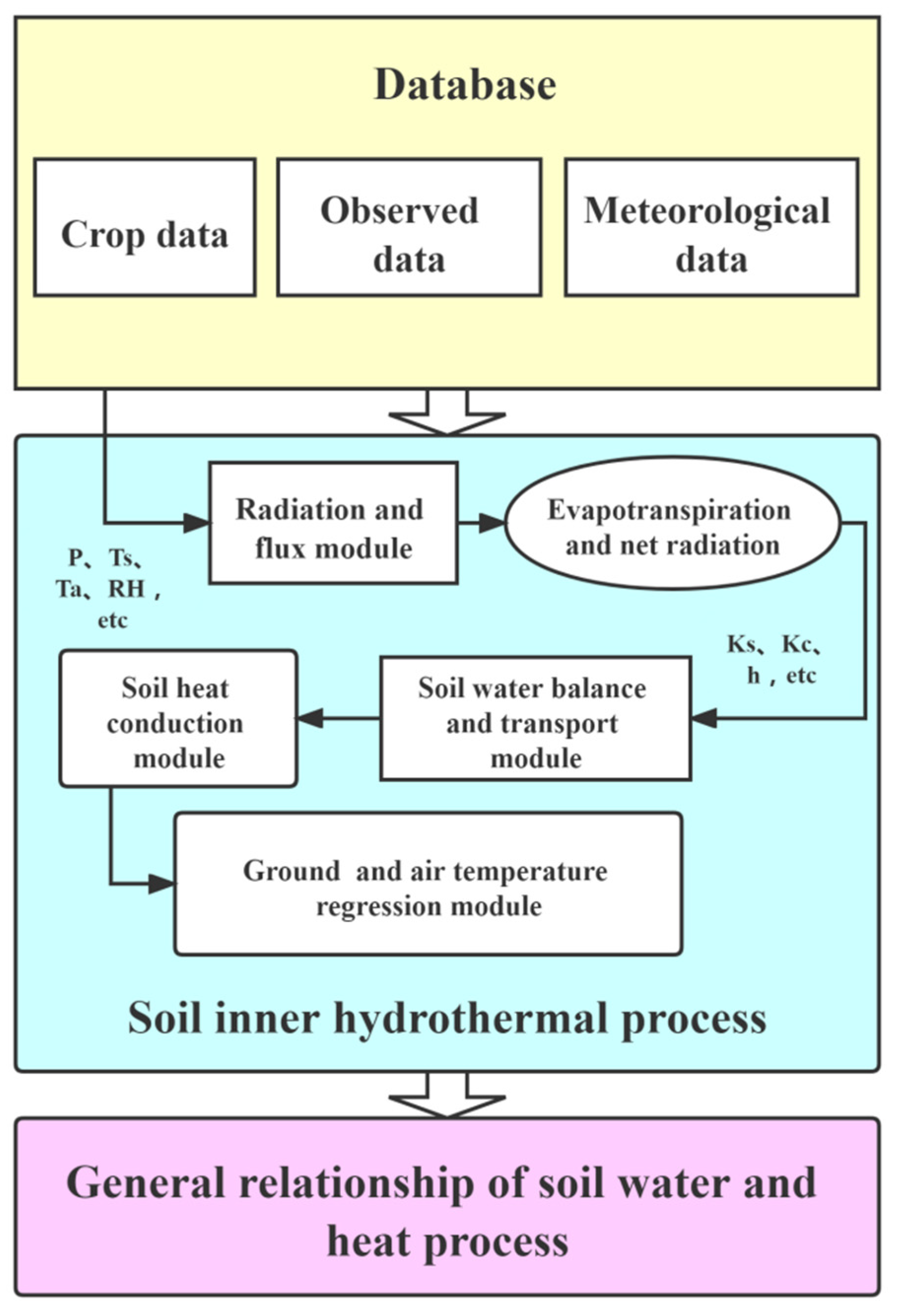
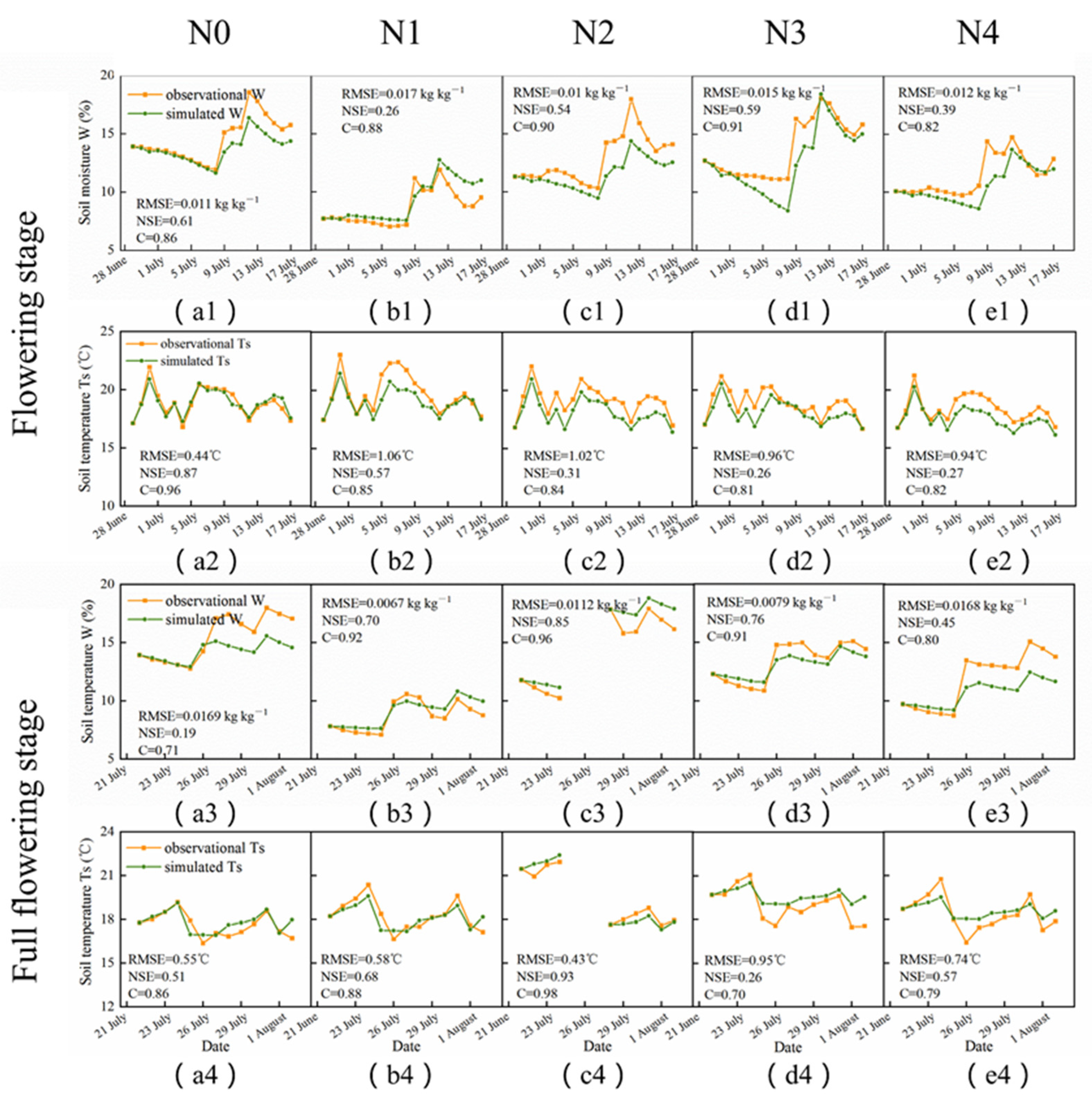


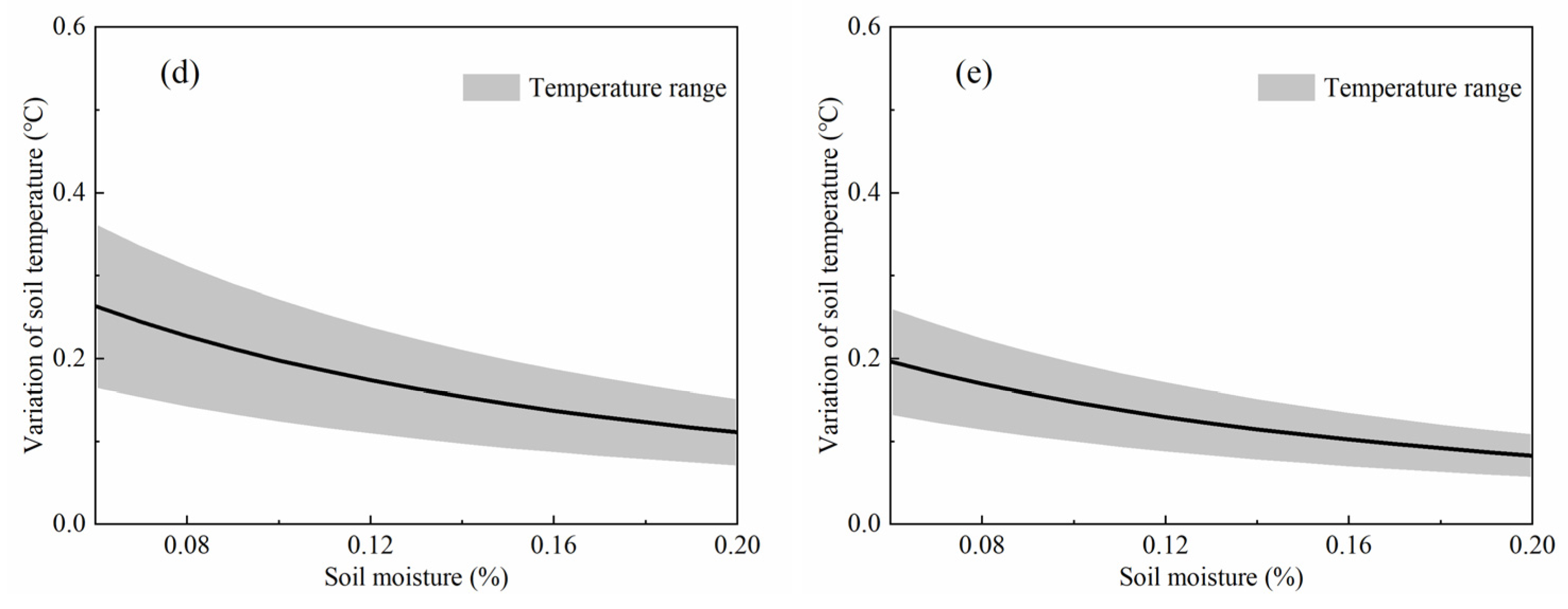


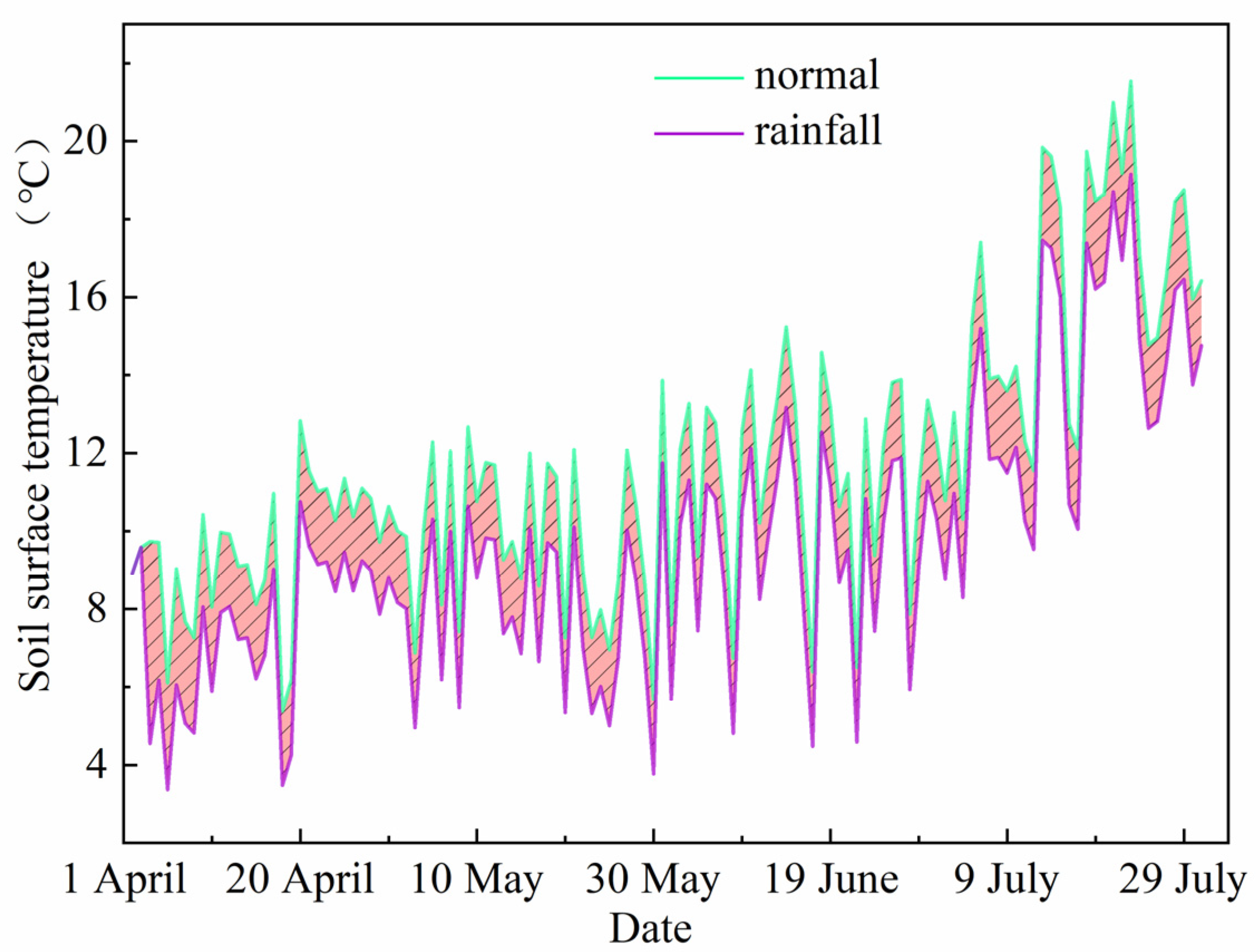
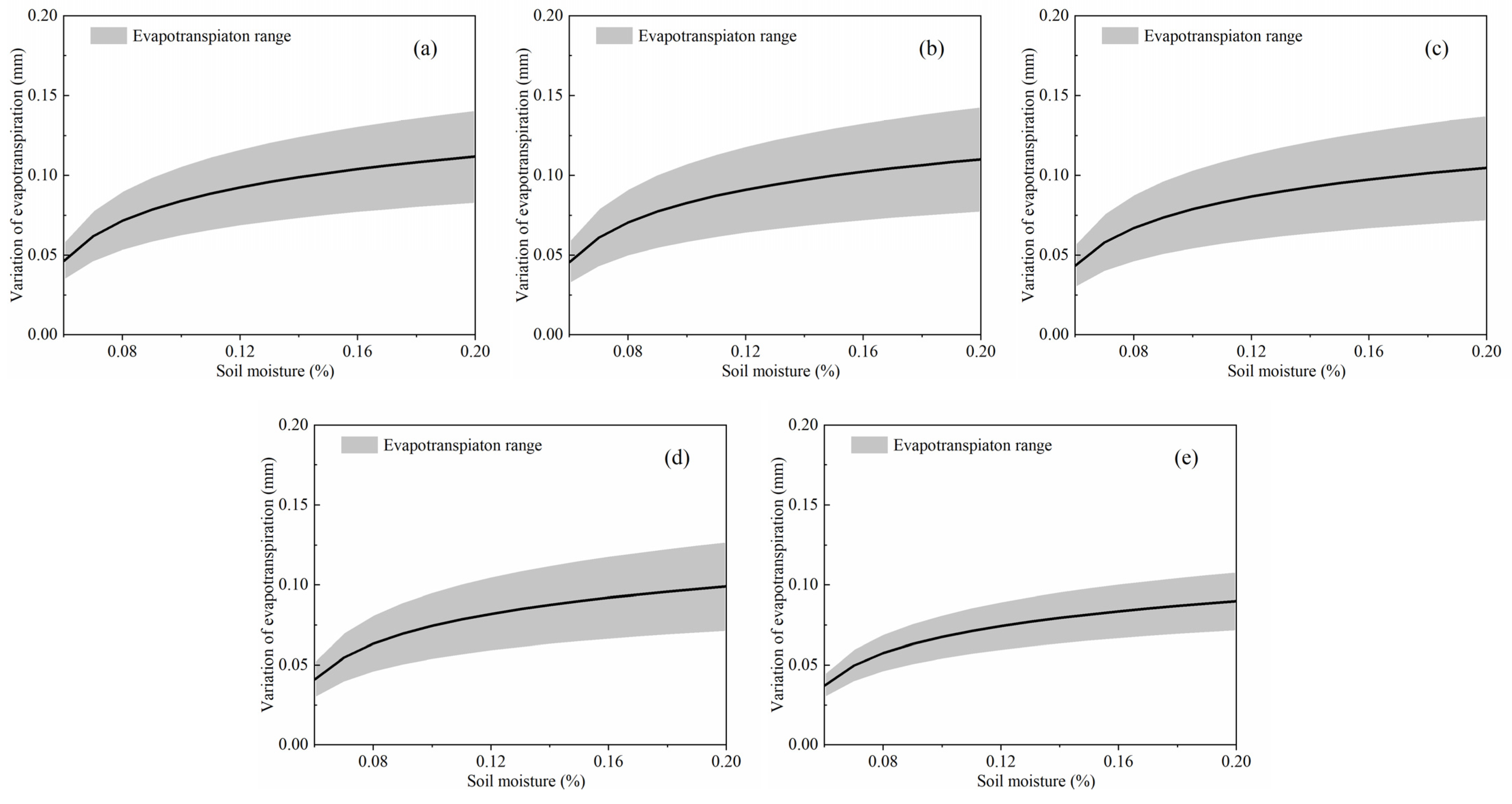
| Number | Treatment | Fertilizer Rate (kg ha−1) | ||
|---|---|---|---|---|
| N | P2O5 | K2O | ||
| 1 | N0 | 0 | 91 | 238 |
| 2 | N1 | 104.5 | 91 | 238 |
| 3 | N2 | 156.75 | 91 | 238 |
| 4 | N3 | 209 | 91 | 238 |
| 5 | N4 | 313.5 | 91 | 238 |
| Parameter | Description | Value |
| H | Altitude (m) | 1600 |
| K | Soil thermal diffusivity (m2 s−1) | 0.37 × 10−6 |
| Cs | Soil heat capacity (J kg−1 K−1) | 0.8 × 103 |
| ρ | Soil particle density (kg m−3) | 1.5 × 103 |
| esco | Evaporation compensation coefficient | 0.1 |
| Hcrop | Crop height (m) | 0.3 |
| Γ | transmissivity | 0.5 |
| S* | Field capacity (%) | 20 |
| Sw | Wilting coefficient (%) | 5 |
| CN | Runoff curve coefficient | 80 |
Publisher’s Note: MDPI stays neutral with regard to jurisdictional claims in published maps and institutional affiliations. |
© 2022 by the authors. Licensee MDPI, Basel, Switzerland. This article is an open access article distributed under the terms and conditions of the Creative Commons Attribution (CC BY) license (https://creativecommons.org/licenses/by/4.0/).
Share and Cite
Zhang, Z.; Chen, X.; Pan, Z.; Zhao, P.; Zhang, J.; Jiang, K.; Wang, J.; Han, G.; Song, Y.; Huang, N.; et al. Quantitative Estimation of the Effects of Soil Moisture on Temperature Using a Soil Water and Heat Coupling Model. Agriculture 2022, 12, 1371. https://doi.org/10.3390/agriculture12091371
Zhang Z, Chen X, Pan Z, Zhao P, Zhang J, Jiang K, Wang J, Han G, Song Y, Huang N, et al. Quantitative Estimation of the Effects of Soil Moisture on Temperature Using a Soil Water and Heat Coupling Model. Agriculture. 2022; 12(9):1371. https://doi.org/10.3390/agriculture12091371
Chicago/Turabian StyleZhang, Ziyuan, Xiao Chen, Zhihua Pan, Peiyi Zhao, Jun Zhang, Kang Jiang, Jialin Wang, Guolin Han, Yu Song, Na Huang, and et al. 2022. "Quantitative Estimation of the Effects of Soil Moisture on Temperature Using a Soil Water and Heat Coupling Model" Agriculture 12, no. 9: 1371. https://doi.org/10.3390/agriculture12091371






